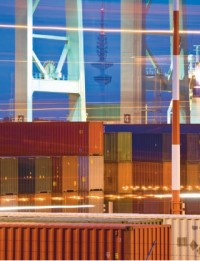


Compared to current practice, the efficiency can often be improved by pooling vehicles. Similar vehicle routing problems arise on the land side, where containers are transported between the storage blocks and the railhead and where external trucks must be scheduled and routed through the terminal.
The intermediate storage area is organized in rectangular blocks that are either served directly by the straddle carriers, which can stack containers up to three or sometimes four high, or by rubber tired or rail mounted gantry cranes (RTMG and RMG) that can typically stack up to five or six high. For example, an RMG block at the CTB can hold well over 2000 standard containers. At newer facilities the operation of the RMG cranes is fully automatic with two or even three cranes per storage block. Crane scheduling is concerned with the online optimization of the stacking cranes. The objective is to minimise the travel times of the cranes and delays and waiting times at the interfaces of the storage blocks. Online crane scheduling is also needed at the rail interface to unload and load rail cars.
